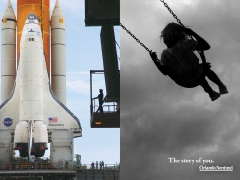 Will this “ovum drive” solve my problems?
Will this “ovum drive” solve my problems?
Trendwatching.com talks about services like Google’s Gmail offering massive amounts of free storage and memory sticks that can store up to 1 GB* of content that are being worn on lanyards as a fashion accessory. (*actually, some can store even more).
The week I read the Life Caching article, I had a major computer meltdown. My Mac G4 wouldn’t start up, and I could not access any of my data. I back up my data every few months, but when I had last done it in June, I had problems with the backup, so it ended up being rather spotty.
I had a lovely new storage device that held 4 gigs of data, but I had never gotten around to backing up my data on it. I could have easily saved the most important stuff. But I hadn’t.
Here, I must digress and briefly discuss my obsession with storage devices. I have long been passionate about everything from Tupperware to plastic storage boxes to stackable shelves and baskets to Zip drives. When I walk through the plastic bin aisle in Target or page through a catalog with storage vessels, I feel a palpable longing inside and I verge on hyperventilation. I have a theory that women are attracted to these storage items because they remind us of our wombs. (Yes, I am a complete whacko).
I had even nicknamed my 4-gig storage device my U-drive, as in U for uterus. But I had never impregnated my U-drive with data.
The period of four days before I knew the verdict on my data was agonizing (I say that realizing how stupid it sounds when hurricane victims on the Gulf coast are in real agony and my son during this same period was suffering tremendous pain with pancreatitis).
But I live and die by my computer. I spend hours on it, and I feel as though so many pieces of my life are contained within it — so many of my stories. I was especially scared that I had lost my e-mail files. As Trendwatching points out, “email [is rapidly turning into] the new LIFE CACHING database of choice, for business professionals and consumers alike: consumers increasingly email data to themselves, as their email accounts are always online and email search is getting more efficient and labeling of messages is becoming more sophisticated.” These words totally apply to me. My stories, my research, my contacts, my work are all wrapped up in my e-mail. I have long contended that my 12-year e-mail correspondence with my first cousin/best friend Liz is a form of journaling. (Despite our closeness, we’ve talked on the phone only twice in those dozen years.)
As it happened, a guy who goes by “The Mac Doctor” succeeded in getting my computer going again AND retrieving every last bit of my data. He’s my hero. Of course, the first thing I did after it was fixed was back up my data on my U drive.
All was bliss for about a week — until my U-drive failed, some sort of sinister menopausal metaphor, no doubt. I’ve now ordered a round storage device that holds 5 gigs and looks a little like a donut. I shall call it my O for Ovum and hope to successfully store my stories on it.





